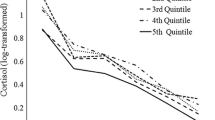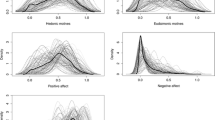Abstract
Fifty-four older adults ranging in age from 70 to 86 years old (M = 77.54) reported daily levels of positive and negative affect, life satisfaction and daily activities for seven consecutive days. Hierarchical linear modeling (HLM) was used to investigate inter- and intra-individual effects of flow experiences on affect. Higher quality of flow was positively associated with high arousal positive affect (i.e., feeling peppy, enthusiastic, happy), negatively associated with low arousal negative affect (i.e., feeling sad and disappointed), and positively associated with life satisfaction. However, more frequent flow experiences throughout the week predicted lower average levels of positive affect and life satisfaction. Overall, the results demonstrate that flow is linked to the affective experiences of older adults, and that an individual’s overall propensity to experience flow may be influential beyond the immediate effects of a given flow experience.
Similar content being viewed by others
References
Asakawa, K. (2004). Flow experience and autotelic personality in Japanese college students: How do they experience challenges in daily life? Journal of Happiness Studies, 5(2), 123–154. doi:10.1023/B:JOHS.0000035915.97836.89.
Baltes, P., & Mayer, K. U. (1999). The Berlin aging study: Aging from 70 to 100. Cambridge, UK: Cambridge University Press.
Blazer, D. (2003). Depression in late life: Review and commentary. Journal of Gerontology: Medical Sciences, 58A(3), 249–265.
Bradburn, N. M. (1969). The structure of psychological well-being. Oxford, England: Aldine.
Brandtstaedter, J., & Wentura, D. (1995). Adjustment to shifting possibility frontiers in later life: Complementary adaptive modes. In R. A. Dixon & L. Bäckman (Eds.), Compensating for psychological deficits: Managing losses and promoting gains (pp. 83–105). Mahwah, NJ: L. Erlbaum Associates.
Cacioppo, J. T., & Bernston, G. G. (1999). The affect system: Architecture and operating characteristics. Current Directions in Psychological Science, 8(5), 133. doi:10.1111/1467-8721.00031.
Cacioppo, J. T., Garnder, W. L., & Bernston, G. G. (1999). The affect system has parallel and integrative processing components: Form follows function. Journal of Personality and Social Psychology, 76(5), 839. doi:10.1037/0022-3514.76.5.839.
Cantril, H. (1999). The pattern of human concerns. New Brunswick, NJ: Rutgers University Press.
Carstensen, L. L. (1995). Evidence for a life-span theory of socioemotional selectivity. Current Directions in Psychological Science, 4(5), 151–156. doi:10.1111/1467-8721.ep11512261.
Carstensen, L. L., Pasupathi, M., Mayr, U., & Nesselroade, J. R. (2000). Emotional experience in everyday life across the adult life span. Journal of Personality and Social Psychology, 79(4), 644–655. doi:10.1037/0022-3514.79.4.644.
Csikszentmihalyi, M. (1982). Toward a psychology of optimal experience. In L. Wheeler (Ed.), Review of personality and social psychology (Vol. 2, pp. 13–36). Beverly Hills: Sage.
Csikszentmihalyi, M. (1988). The flow experience and human psychology. In M. Csikszentmihalyi & I. Csikszentmihalyi (Eds.), Optimal experience: Psychological studies of flow in consciousness (pp. 15–35). Cambridge, England: Cambridge University Press.
Csikszentmihalyi, M. (1990). Flow: The psychology of optimal experience. New York: Harper Collins.
Csikszentmihalyi, M., & Figurski, T. (1982). Self-awareness and aversive experience in everyday life. Journal of Personality, 50(1), 15–28. doi:10.1111/j.1467-6494.1982.tb00742.x.
Csikszentmihalyi, M., & Hunter, J. (2003). Happiness in everyday life: The uses of experience sampling. Journal of Happiness Studies, 4(2), 185–199.
Csikszentmihalyi, M., & LeFevre, J. (1989). Optimal experience in work and leisure. Journal of Personality and Social Psychology, 56(5), 815–822. doi:10.1037/0022-3514.56.5.815.
Csikszentmihalyi, M., & Rathunde, K. (1993). The measurement of flow in everyday life. Nebraska Symposium on Motivation, 40, 57–97.
Dannefer, D. (1987). Aging as intracohort differentiation: Accentuation, the Matthew effect, and the life course. Sociological Forum, 2(2), 211–236. doi:10.1007/BF01124164.
Diener, E., & Suh, E. (1997). Measuring quality of life: Economic, social and subjective indicators. Social Indicators Research, 40, 189–216. doi:10.1023/A:1006859511756.
Diener, E., Oishi, S., & Lucas, R. (2003a). Personality, culture and subjective well-being: Emotional and cognitive evaluations of life. Annual Review of Psychology, 54, 403–425. doi:10.1146/annurev.psych.54.101601.145056.
Diener, E., Scollon, C. N., & Lucas, R. E. (2003b). The evolving concept of subjective well-being: The multi-faceted nature of happiness. In P. T. Costa & I. C. Siegler (Eds.), Advances in cell aging and gerontology (Vol. 15, pp. 187–219). New York: Elsevier Science.
Feldman Barrett, L., & Russell, J. (1998). Independence and bipolarity in the structure of current affect. Journal of Personality and Social Psychology, 74(4), 967–984. doi:10.1037/0022-3514.74.4.967.
Fredrickson, B. L. (2001). The role of positive emotions in positive psychology: The broaden-and-build theory of positive emotions. The American Psychologist, 56(3), 218–226. doi:10.1037/0003-066X.56.3.218.
Gallup Poll. (1988). Omnibus, III.
Greenberg, J., & Pyszczynski, T. (1986). Persistent high self-focus after failure and low self-focus after success: The depressive self-focusing style. Journal of Personality and Social Psychology, 50(5), 1039–1044. doi:10.1037/0022-3514.50.5.1039.
Gross, J. J., Carstensen, L. L., Pasupathi, M., Tsai, J., Goetestam Skorpen, C., & Hsu, A. Y. C. (1997). Emotion and aging: Experience, expression, and control. Psychology and Aging, 12(4), 590–599. doi:10.1037/0882-7974.12.4.590.
Hamer, D. H. (1996). The heritability of happiness. Nature Genetics, 14(2), 125–126. doi:10.1038/ng1096-125.
Han, S. (1988). The relationship between life satisfaction and flow in elderly Korean immigrants. In M. Csikszentmihalyi & I. S. Csikszentmihalyi (Eds.), Optimal experience: Psychological studies of flow in consciousness (pp. 138–149). New York, NY: Cambridge University Press.
Headey, B., & Wearing, A. (1989). Personality, life events, and subjective well-being: Toward a dynamic equilibrium model. Journal of Personality and Social Psychology, 57(4), 731–739. doi:10.1037/0022-3514.57.4.731.
Hendricks, J., & Hendricks, C. D. (1986). Aging in mass society: Myths and realities. Boston: Little Brown.
Ingram, R. E. (1990). Self-focused attention in clinical disorders: Review and a conceptual model. Psychological Bulletin, 107, 156–176. doi:10.1037/0033-2909.107.2.156.
Isaacowitz, D., & Smith, J. (2003). Positive and negative affect in very old age. Journal of Gerontology: Psychological Sciences, 58B(3), P143–P152.
Kahneman, D., Krueger, A. B., Schkade, D. A., Schwarz, N., & Stone, A. A. (2004). A survey method for characterizing daily life experience: The day reconstruction method. Science, 306, 1776–1780. doi:10.1126/science.1103572.
Kim, J. E., & Moen, P. (2002). Retirement transitions, gender, and psychological well-being: A life-course, ecological model. Journal of Gerontology, 57(3), 212–222.
Kunzmann, U., Little, T. D., & Smith, J. (2000). Is age-related stability of subjective well being a paradox? Cross-sectional and longitudinal evidence from the Berlin aging study. Psychology and Aging, 15(3), 511–526. doi:10.1037/0882-7974.15.3.511.
Labouvie-Vief, G., Hakim-Larson, J., DeVoe, M., & Schoeberlein, S. (1989). Emotions and self-regulation: A life span view. Human Development, 32(5), 279–299.
Lawton, M. P. (1989). Environmental proactivity and affect in older people. In S. Spacapan & S. Oskamp (Eds.), The social psychology of aging. Claremont symposium on applied social psychology (pp. 135–163). Thousand Oaks, CA: Sage.
Lawton, M. P., DeVoe, M. R., & Parmelee, P. (1995). Relationship of events and affect in the daily life of an elderly population. Psychology and Aging, 10(3), 469–477. doi:10.1037/0882-7974.10.3.469.
Lucas, R. E., Clark, A. E., Georgellis, Y., & Diener, E. (2003). Reexamining adaptation and the set point model of subjective well-being: Reactions to changes in marital status. Journal of Personality and Social Psychology, 84(3), 527–539. doi:10.1037/0022-3514.84.3.527.
Mroczek, D. K., & Kolarz, C. M. (1998). The effect of age on positive and negative affect: A developmental perspective on subjective well-being. Journal of Personality and Social Psychology, 75(5), 1333–1349. doi:10.1037/0022-3514.75.5.1333.
Norris, W. N. (1999). The mood system. In D. Kahneman, E. Diener, & N. Schwarz (Eds.), Well-being: The foundations of hedonic psychology (pp. 169–189). New York: Russell Sage.
Pavot, W., & Diener, E. (2004). The subjective evaluation of well-being in adulthood: Findings and implications. Ageing International, 29(2), 113–135. doi:10.1007/s12126-004-1013-4.
Pavot, W., Diener, E., Colvin, C. R., & Sandvik, E. (1991). Further validation of the Satisfaction with Life Scale: Evidence for the cross-method convergence of well-being measures. Journal of Personality Assessment, 57(1), 149–161. doi:10.1207/s15327752jpa5701_17.
Pinquart, M., & Schindler, I. (2007). Changes of life satisfaction in the transition to retirement: A latent class approach. Psychology and Aging, 22(3), 442–455. doi:10.1037/0882-7974.22.3.442.
Pressman, S. D., & Cohen, S. (2005). Does positive affect influence health? Psychological Bulletin, 131(6), 925–971. doi:10.1037/0033-2909.131.6.925.
Raudenbush, S., & Bryk, A. (2002). Hierarchical linear models: Applications and data analysis methods. Thousand Oaks, CA: Sage.
Rowe, J. W., & Kahn, R. L. (1997). Successful aging. The Gerontologist, 37(4), 433–440.
Ryan, R. M., & Deci, E. L. (2001). On happiness and human potentials: A review of research on hedonic and eudaimonic well-being. Annual Review of Psychology, 52, 141–166. doi:10.1146/annurev.psych.52.1.141.
Ryff, C. D. (1989). In the eye of the beholder: Views of psychological well-being among middle-aged and older adults. Psychology and Aging, 4(2), 195–210. doi:10.1037/0882-7974.4.2.195.
Ryff, C. D., Dienberg Love, G., Urry, H. L., Muller, D., Rosenkranz, M. A., Friedman, E. M., et al. (2006). Psychological well-being and ill-being: Do they have distinct or mirrored biological correlates? Psychotherapy and Psychosomatics, 75(2), 85–95. doi:10.1159/000090892.
Salovey, P., Rothman, A. J., Detweiler, J. B., & Steward, W. T. (2000). Emotional states and physical health. The American Psychologist, 55(1), 110–121. doi:10.1037/0003-066X.55.1.110.
Smith, D. (2003). The older population in the United States: March 2002. U.S. Census Bureau Current Population Reports, P20-546. Washington, DC.
Snijders, T., & Bosker, R. (1999). Multilevel analysis. London: Sage.
Spybrook, J., Raudenbush, S. W., Liu, X., & Congdon, R. (2006). Optimal design for longitudinal and multilevel research: Documentation for the “Optimal Design” software. http://sitemaker.umich.edu/group-based/files/odmanual-20060919-v176.doc.
Stacey, C. A., & Gatz, M. (1991). Cross-sectional age differences and longitudinal change on the Bradburn Affect Balance Scale. Journal of Gerontology, 46, 76–78.
Voelkl, J. E. (1990). The challenge skill ratio of daily experiences among older adults residing in nursing homes. Therapeutic Recreation Journal, 24(2), 7–17.
Voelkl, J., & Ellis, G. (1998). Measuring flow experiences in daily life: An examination of the items used to measure challenge and skill. Journal of Leisure Research, 30(3), 380–389.
Wang, M. (2007). Profiling retirees in the retirement transition and adjustment process: Examining the longitudinal change patterns of retirees’ psychological well-being. The Journal of Applied Psychology, 92(2), 455–474. doi:10.1037/0021-9010.92.2.455.
Wells, A. J. (1988). Self-esteem and optimal experience. In M. Csikszentmihalyi & I. Csikszentmihalyi (Eds.), Optimal experience: Psychological studies of flow in consciousness (pp. 327–341). Cambridge, England: Cambridge University Press.
Witt, P., & Ellis, G. (1987). The leisure diagnostic battery users manual. State College, PA: Venture Publishing.
World Values Study Group. (1994). World values survey, 1981–1984 and 1990–1993. Ann Arbor, MI: Institute for Social Research, University of Michigan.
Author information
Authors and Affiliations
Corresponding author
Rights and permissions
About this article
Cite this article
Collins, A.L., Sarkisian, N. & Winner, E. Flow and Happiness in Later Life: An Investigation into the Role of Daily and Weekly Flow Experiences. J Happiness Stud 10, 703–719 (2009). https://doi.org/10.1007/s10902-008-9116-3
Received:
Accepted:
Published:
Issue Date:
DOI: https://doi.org/10.1007/s10902-008-9116-3




